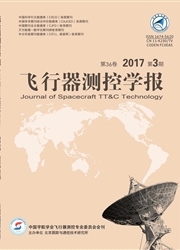

 中文摘要:
中文摘要:
"嫦娥二号"实施小行星探测试验,与小行星交会时卫星距离地球约700万km,此飞行阶段卫星定轨计算精度非常依赖于测轨数据的弧长。卫星最后两次轨道修正只有13天时间,而实现小行星拍照试验指标要求轨道精度优于15km。如何利用有限的测轨数据实现高精度定轨是小行星探测试验必须解决的重要问题。针对控后跟踪弧段有限的特点,以10月9日控后飞行阶段为分析对象,设计了不同的定轨策略,并比较定轨计算的精度。计算结果表明,融合轨控前后的测轨数据开展定轨计算,可以有效提升定轨计算精度。利用控前1个月和控后10天的测轨数据进行定轨计算与控后6周数据定轨计算精度相当。
 英文摘要:
英文摘要:
Chang'E-2 is about 7 000 000 km away from the earth during a fly-by experiment with Toutatis when tak- ing snaps of the asteroid. Orbit determination accuracy in the flight phase is significantly dependent on the tracking- are length. While orbit determination accuracy should be better than 15 km for photographing the target and with only 13 days left before Chang'E 2's encounter with the asteroid following its last orbit correction, it is quite a challenge to meet the accuracy requirement with the data available in the 13 days. This paper designs different orbit de termination strategies for the test of the reconstructed orbit accuracy with limited data. Results show that a better orbit accuracy can be attained by combination of data before and after orbit control. Besides, orbit determination ac curacy with one month tracking data before and 10-day data after the orbit control is equivalent to that using 6 week data after the orbit control at the stable flying segment.
 同期刊论文项目
同期刊论文项目
 同项目期刊论文
同项目期刊论文
 期刊信息
期刊信息
